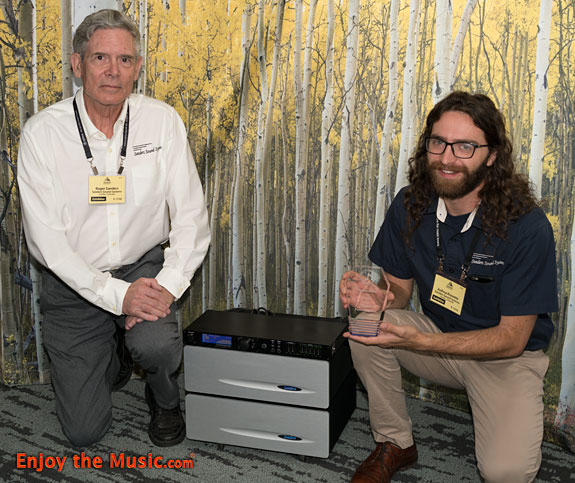Show Coverage
Enjoy the Music - Sanders Sound Systems @ RMAF 2019
The Best Of 2019 Blue Note Award winning Sanders Sound Systems Magtech stereo amplifier ($5500) was here at RMAF 2019 driving a pair of outstanding Model 10e electrostatic speakers ($17,000), with the price including a digital Loudspeaker Management System (LMS). Do note that the $17,000 price for the speakers includes one of their Magtech amplifiers as well as the digital LMS. This is the best option for those who wish to provide a second amp of their own to power Sanders Sound Systems' speakers. The other option, which they've displayed at the show, is to buy the speakers with two Magtechs for $22,500. And yes their ESL Mk II amplifier ($4500), which is Sanders Sound System's original amplifier, was also @ RMAF 2019.
There was also a special premiere of their Digital Preamplifier ($5500) to be released this fall. For lovers of turntables, they also offer a Phono Preamplifier ($4500). Of note is that specialized cables are within their system and consist of Sanders Sound System's ESL Speaker Cables ($600 per pair), unbalanced Interconnects ($100 per pair), and XLR balanced Interconnects ($150 per pair).
for the rest of the coverage, please click the image below.
Part-time Audiophile - Sanders Sound System | T.H.E. SHOW 2019
Sanders Sound System | T.H.E. SHOW 2019
Posted on July 13, 2019 by in THE Show 2019
LOS ANGELES (PTA) — Sanders Sound Systems of Conifer, Colorado made the trek out to the miserably fantastic sunny weather of southern California, with the hopes of bringing a little of their own sunshine to the affair with powerful one-brand ESL loudspeaker system.
click on image to read full coverage
Part-Time Audiophile - Axpona 2017 Coverage
AXPONA 2017: Sanders rewards listening without prejudice
May 13, 2017 by in AXPONA 2017
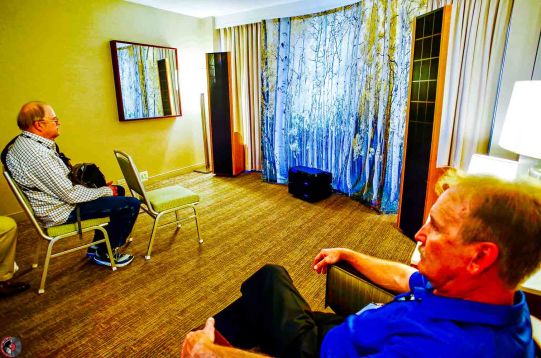
I’ve been raving about Sanders Sound Systems’ amazing Model 10e hybrid electrostatics for so long now, I’m afraid of being accused of taking payola.
Regular readers know that Part-Time Audiophile doesn’t play that game, though. What we hear is what we write.
To me, when a speaker performs the way Sanders’ design does — and still doesn’t get a whole lot of ink — it’s hard to throttle down much.
Electrostatics are a different animal. It seems in the high-end, speaker enthusiasts either love them in a cult-like fashion (Quad’s ESLs, for instance, still attract hard-core fans 60 years after their introduction) or they are stubbornly skeptical.
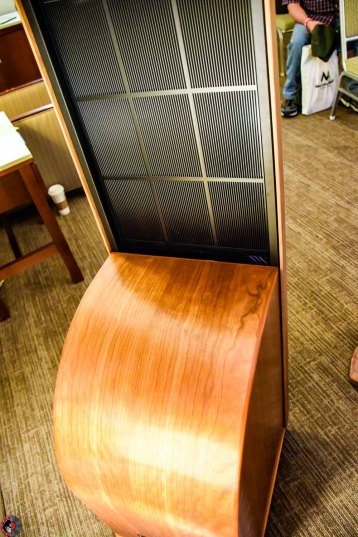
Far too many hobbyists, I’m convinced, cling to stereotypes without testing them thoroughly with their own ears. I think the Sanders 10e is a case in point.
Electrostats have rolled-off highs, right? They can’t play loud. They sound threadbare. They don’t do bass. Rock dynamics? Forget about it!
Some audiophiles believe all of that. (Wait, wait, I left one out: They are unreliable.) A varying number of those things indeed are true of some — but far from all — ‘stats that have been produced throughout the past few decades. But, hello, this is 2017.
Roger Sanders, who builds his speakers by hand in Colorado, is an engineer of some talent. Just take a look at the lengthy white papers on his website for his fascinating explanations of how he, through careful testing and modern technology, overcame all of those weaknesses.
His latest flagship, the Model 10e, was on display at AXPONA. Sanders’ goal was to enlighten any audiophile who would come in, close his or her eyes and just listen to the music, rather than glance at a pair of screens and head on down the hallway.
The 10e is a tall, sleek floor-stander. The top two-thirds contains a see-through electrostatic panel, while the much deeper bottom-third holds a 10-inch aluminum woofer. 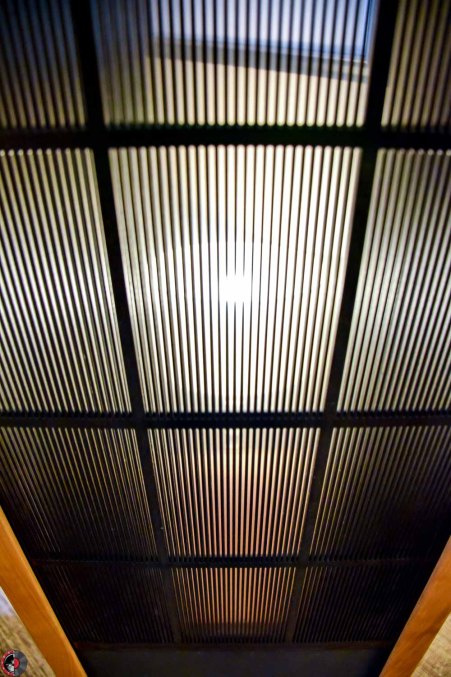
U-oh, here comes another stereotype: Hybrids don’t integrate well. The woofer can’t keep up with the panel and often intrudes into the lower midrange, spoiling the airy vocal reproduction that some bass-shy, panel-only ESLs are known for.
As the late Johnny Carson might have said, “Wrong, solder breath.”
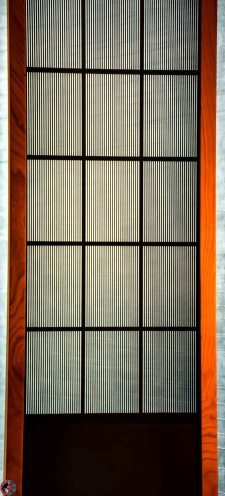
Sanders has taken a long list of steps to make the 10e bust the myths.
Play loud? Check. Accurately reproduce a rock drum kit? Check. Meld the cone woofer nearly seamlessly with the ’stat panel? Check. Radiate extended, non-brittle highs? Check.
To accomplish all this, Sanders made a number of crucial design decisions. He chose an aluminum woofer that offered both speed and depth. He biamps to ensure both panel and cone get plenty of juice. He includes a proprietary preamp/DSP/room-correction unit.
Maybe most importantly, he sets his crossover at 170 Hz to avoid a resonance at 86 Hz and adds a steep 48 decibel-per-octave filter to roll off the bass quickly before it can muddy the bottom of that magic midrange.
During show demos, Sanders’ team likes to turn off the panels while a song — usually something with male vocals and strong bass like a Stevie Ray Vaughan tune — remains playing. The result is stunning. The voice and everything above completely disappears, leaving only kick drum and throbbing bass.
The speakers are even more impressive with all the drivers working. I listened to Vaughan’s “Tin Pan Alley” via a digital file. The 10e offered a breathtaking reproduction of the formidable Double Trouble rhythm section, with Vaughn’s vocals and guitar showing outstanding clarity, focus and weight. Soundstaging also was first-rate, with decays hanging in the air on the atmospheric track.
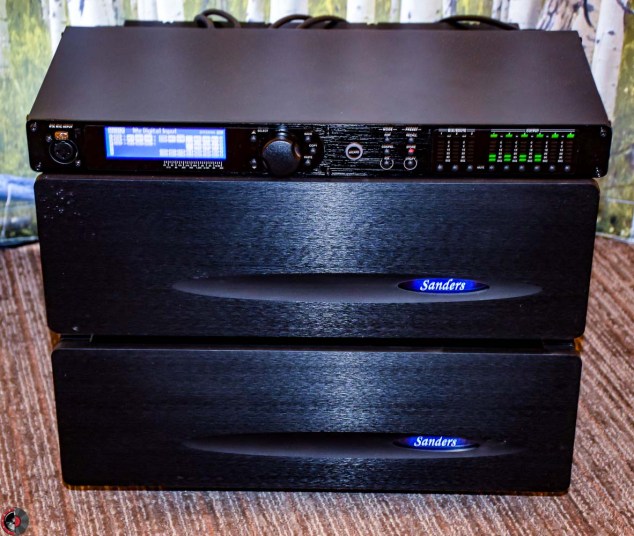
What’s the price of this world-beater? The 10e, which sports beautiful woodwork, by the way, is $17,000 a pair with Sanders’ own 500-watt Magtech amp and the preamp/DSP/room correction unit. Another amp is needed, which the buyer can provide or you can purchase a second Magtech to raise the total to $22,500.
That’s not dirt-cheap, but this is called the high-end, you know. For those whose wallets allow, getting this much technology for that price is practically a steal.
The last time I talked at length with Sanders, he told me about a well-heeled potential customer who was knocked out by the sound of the 10e, but then decided to keep looking.
“He thought he wasn’t spending enough money,” Sanders said, shaking his head.
Sigh. Another stereotype gets in the way of an audiophile’s musical enjoyment. Don’t make the same mistake. Give the 10e a long listen.
Enjoy the Music - RMAF 2017 Show Report
Sanders Sound Systems
Kemper Holt
I've owned many electrostatic loudspeakers in my life, and I still marvel at just how transparent (pun intended), clear, and revealing they can be. Getting them to produce room pressurizing bass and big dynamic swings as well has been the difficulty with many hybrid designs. Roger Sanders seems to have conquered these problems better than most. The Sanders 10e speaker system ($17,000/pr) includes a Sanders Magtech Stereo amplifier ($5,500) and a Sanders Loudspeaker Management System.

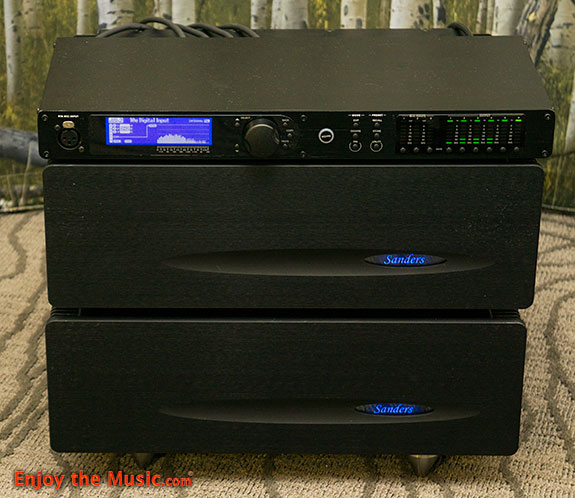
The 10e speakers are bi-amp only, and Roger incorporated a second Magtech stereo amplifier for the demo here, total for the system is $22,500. The LMS is an electronic crossover and room correction device. Roger told me the secret sauce to his design is the use of 48dB/octave slopes between the 10" aluminum coned woofer and the electrostatic panel, centered around 170Hz. This keeps the woofer from blurring the clarity of the panel, and allows the panel to keep up with the woofer without straining or exciting it's resonant frequency.
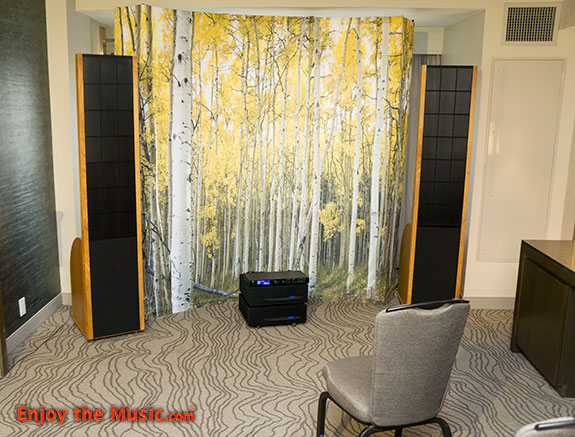
Here we have electrostatic detail and clarity along with huge dynamics and room crushing bass response. Transients were quick and accurate, cymbals and rim shots were sensational. Stevie Ray Vaughn rocking out to "Tin Pan Alley" was breathtaking, drum kit had great impact, guitar cut through everything, vocals revealing and real sounding. One of my Denver friends brought his son to the show Sunday and this was one of three rooms that stunned them, so clear and real sounding they reported, I have to agree, great room Roger.
Part Time Audiophile - RMAF 2016 Coverage
Articles by
John Stancavage
. . . I started out with a simple query (“How do you keep the cone-driven bass from intruding into the panels?”). And, before I knew it, 45 minutes had gone by. It seemed like a fraction of that time, though, as I got a primer on speaker-building and electrostatics from a man who — to paraphrase “Lethal Weapon” — may have forgotten more about those subjects than most engineers will ever know.
The sound of the Model 10e was still reverberating in my ears. The demo had included a wide variety of musical genres, including jazz, pop and rock, along with the usual drum-and-percussion-heavy, audio-show tracks. . .
Darryl Lindberg
. . .I admit it: I’m an absolute sucker for electrostatic speakers. There’s just nothing like the presentation of a good electrostatic speaker in terms of speed, delicacy, transparency, and very low distortion. And the Sanders Sound System setup featuring their Model 10e ($17K, including the Sanders Magtech amplifier) sounded much better than merely “good;” in fact, it sounded excellent to my ears. The 10e features a 15”x42” electronic panel over a 10” aluminum transmission line-loaded woofer, adding up to an elegant 69” package that should suit a variety of rooms. Although the selections played while I was in the room were unfamiliar, there was no mistaking that ol’ electrostatic black magic: crystal clear and three dimensional as all get out. . .
To read both in full, please follow this link.
https://parttimeaudiophile.com/2016/10/26/rmaf-2016-sanders-goes-his-own-way/

